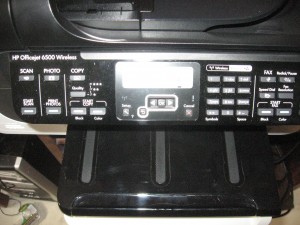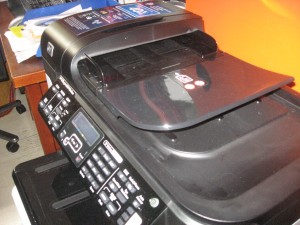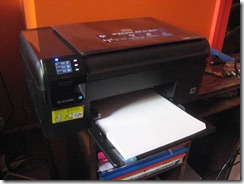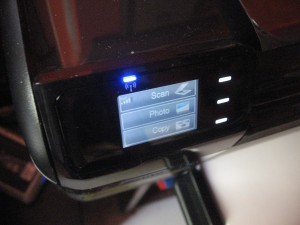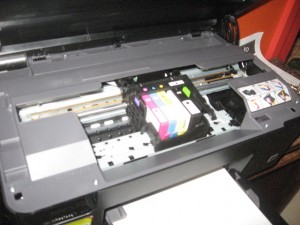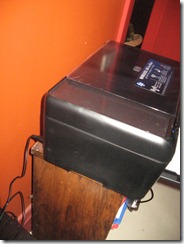Product Review- Hewlett-Packard OfficeJet 6500 all-in-one printer
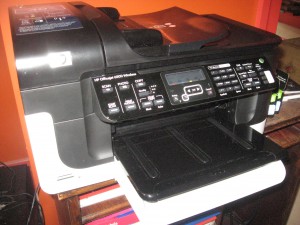 In this review, I have been given the opportunity to assess a multifunction printer that is optimised for small-business use rather than a consumer-rated unit. These units are designed to be economical to run, have high-speed throughput for scanning and printing; as well as supporting a higher duty cycle than the consumer units.
In this review, I have been given the opportunity to assess a multifunction printer that is optimised for small-business use rather than a consumer-rated unit. These units are designed to be economical to run, have high-speed throughput for scanning and printing; as well as supporting a higher duty cycle than the consumer units.
The HP OfficeJet 6500 is a size similar to most multifunction printers and has the controls located closer to the user. It has a large high-contrast two-line LCD monochrome display which is good as a status display for tasks like faxing or scanning. The controls are arranged in a task-specific manner that makes it easier to perform what you want to do.
Setup
The only assembly that you would have needed to do beyond installing the ink cartridges is to attach the duplexer mechanism to the back of the printer. This unit, which looks like a laser printer’s toner cartridge just snapped in to the back without much effort.
As far as connections go, the printer can be directly connected to the host computer via USB or it can be connected to an Ethernet wired network or a WiFi wireless network. There are two RJ11 phone sockets for use when setting the unit up as a fax machine. This is to permit you to connect existing telephone devices to the unit thus obviating the need to use a splitter.
The printer comes with a CD-ROM which has all of the drivers and applications needed to get the printer going, but it would be a good idea to download the latest drivers from HP’s Web site. This also means that newer operating systems like Windows 7 or MacOS X “Snow Leopard” will be catered for.
Loading ink cartridges
You don’t need much effort to open or close the lid to install new ink cartridges. As well, like the Photosmart Wireless multifunction printer that I reviewed previously, you don’t have to mess with any stays to keep the lid open while changing the cartridges. Similarly, you don’t need much effort to remove or install the ink cartridges and there is nothing “fiddly” about this job.
Network setup and abilities
This printer can work in a small network as a network printer or scanner. It connects to the network either via 802.11g WPA2 wireless or Cat5 Ethernet cable, which can also work in conjunction with a better Wi-Fi client bridge or an existing-wires technology like HomePlug powerline or MoCA TV coaxial.
You can use the printer’s control panel to enrol it with a wireless network, including entering the WPA-PSK passphrase using the numeric keypad in a manner similar to how a teenager taps out a text message on their mobile phone. On the other hand, you can use the USB port and the supplied software to configure the printer for your wireless network. It doesn’t support WPS easy-configure modes, but this omission may not be missed in a lot of business setups.
If the printer is connected wirelessly to the network, it can lose touch with the network when it goes in to low-power state and you may have to turn it off and on using the ON/OFF switch on the control panel when you want to start printing. This problem is due to the absence of a standard “wake-on-wireless-network” protocol for activating network devices connected to a wireless network that have entered a low-power state. This problem doesn’t occur if the printer is connected via an Ethernet network whether directly or via a HomePlug segment.
There is a built-in Web server that is used for managing the unit and this is accessible through a shortcut on the HP software. Windows Vista and 7 computers can gain access to this interface through the “Network” option as part of the DPWS technology that is part of the operating systems. There is also the ability to start “plug-and-play” installation from this interface by right-clicking on the printer icon in the Network folder and selecting “Install”. Here, you would need to make sure that the drivers are installed in the computer beforehand.
Use
Printing
The OfficeJet 6500 Wireless comes with a rear-mounted duplexer attachment so you can save paper by printing on both sides. The only disadvantage with this is that the document has to have a larger bottom margin so that the duplexer can properly handle the paper when turning it over.
I have the printer print a large document (214 page user manual) with double-sided printing in order to assess how it goes with handling a large print run. This would mimic conditions similar to printing a large report or something similar; or simply sustaining a large run of documents. I have then found that it could complete this kind of job unattended without printing-reliability issues.
Scanning
This OfficeJet unit can also work as a scanner and has an automatic document feeder that is capable of handling 35 pages at a time. Here I ran the automatic document feeder through a reliability test by having the unit copy a 20-page document fed through the feeder and it performed the job properly although there was a high-pitch squealing noise from the ADF. This phenomenon may be particular to the review sample that I was using.
It supports scanning over a network link, either with the scan job initiated at the computer or at the unit’s control panel. The latter method requires you to have the supplied scanner software on your computer to receive and process the documents. This software allows you to scan as a document or picture and save the file to the computer’s local file system or send it as an e-mail.
Use with digital-camera cards
There is a built-in memory card reader for use with digital-camera memory cards but this function is very limited. This is brought about by the printer not having a colour LCD display which can make it easier for you to choose pictures to print. If you want to print selected images, you would need to select the pictures using your camera’s DPOF print selection menus before putting the card in the printer.
Another limitation is that the card reader doesn’t support the SDHC memory cards which are now being used in most of the current digital-camera range. On the other hand, the card reader is accessible over the network as a network storage location with its own drive letter on Windows systems but it can be accessed as the MEMORY_CARD share-name for the printer.
Fax
The OfficeJet 6500 is an inkjet plain-paper fax machine that can work as an elegant replacement for that economy-tier fax machine that many small businesses and home users see as their fax solution.
It can be set up to work on a dedicated line or on a shared line with support for distinctive-ring setups (separate number for fax) or fax auto-answer. The latter mode has it that the unit takes the call if it hears the distinct repeating “CNG” beep from a transmitting fax machine when another device like an answering machine answers the line. When you determine the fax header information, you only need to provide your own name or company name and your fax number rather than having to determine “CSID” and “TSID” fields which can be obscure when you set up fax equipment.
The unit has memory for one outgoing fax job (for scheduled transmission) and is able to keep new received faxes in memory at all times or only during error conditions. There are limitations with this machine’s implementation is that you cannot set the fax machine to receive “only to memory”, a feature which could come in handy for secure “out-of-hours” fax reception; and you cannot schedule multiple outgoing fax jobs, which may be a pain in the neck for people who do a lot of overseas business.
It also supports transmission and reception of colour faxes with compatible fax endpoints and can work in high-resolution modes for “best-case” fax operation. There is a 100-number “speed-dial” list with the first three entries being available for “one-push” access from the control panel.
The unit supports “fax-from-computer” with a dedicated fax print driver and this can be done from any computers that exist on the network. It can also support “fax-to-computer” with jobs ending up at one computer on the network. The “fax-to-computer” mod is limited to monochrome faxes and requires a computer to be alive and running the supplied software all the time.
Output Speed And Quality
The output quality is very typical of a good business inkjet printer and it takes a few seconds per page to print a typical business document. You don’t lose any extra speed when you print colour documents, especially now that most business documents now have some form of colour on them.
If you do double-sided printing, you will have a speed penalty of 10 seconds per sheet of paper to allow the ink to dry on the “first” side of the paper.
Photos printed with this printer have a good dynamic range and the flesh-tones being accurate even when handling a group shot with people of different races. This is on a par with the Photosmart Wireless printer that I reviewed previously and it certainly says that the unit could make a satisfactory effort for printing photos in a “general-purpose” office environment.
Advantages
The unit is easy to use for most tasks and offers a capability set at a price that most small business owners and home-office owners will appreciate. Here, you have functions like an automatic document feeder, double-sided printing and wired / wireless network connectivity as well as separate cartridges for each colour that will be appreciated by the cost-conscious business user.
Limitations and Points of Improvement
I will always be saying this with all consumer and small-business network-ready inkjet printers, especially multifunction printers, is that the manufacturers could improve on the provision of non-volatile onboard memory. This will certainly increase user productivity for improved multi-source print queue management, failed-job recovery, improved fax functionality – more delayed fax sends, receive-to-memory, etc. It can also cater for “CD-free” network printer setup through the Web interface.
Another point of improvement that I would like to see is support for Internet-based (NTP) time synchronisation. This would avoid the need to manually set the time and date whenever ther is a power failure or as part of setting it up. It could then be based on time-zone settings with automatically-updated daylight-savings rules similar to what happens with most computer operating systems.
It can also benefit from the SD card slot supporting SDHC cards in order to work with the newer digital cameras that can use these cards. As well, it could benefit from a USB host port for connection to PictBridge-enabled digital cameras.
Conclusion and Placement
From what I have see, I have described this unit as a capable general-purpose workhorse that suits most small-business and home-office requirements. So I would recommend it be used in a home office or “back office” or “reception-area” in most small organisations. As well, it could work as a colour “general-purpose” multifunction printer for a place like a clinic where one or more monochrome laser printers may be used for receipt printing and similar applications.
The best price that I could get for this printer was AUD$178 from the Officeworks office-supplies chain in Australia. As well, the ink cartridges cost $22.26 each for the colour cartridges and $45 for the black cartridge assuming you are using the 920XL high-capacity cartridges. There is the option of using the cheaper “920” standard-yield cartridges but I would suggest using the 920XL high-yield cartridge for the black ink if you do receive faxes on a regular basis.

